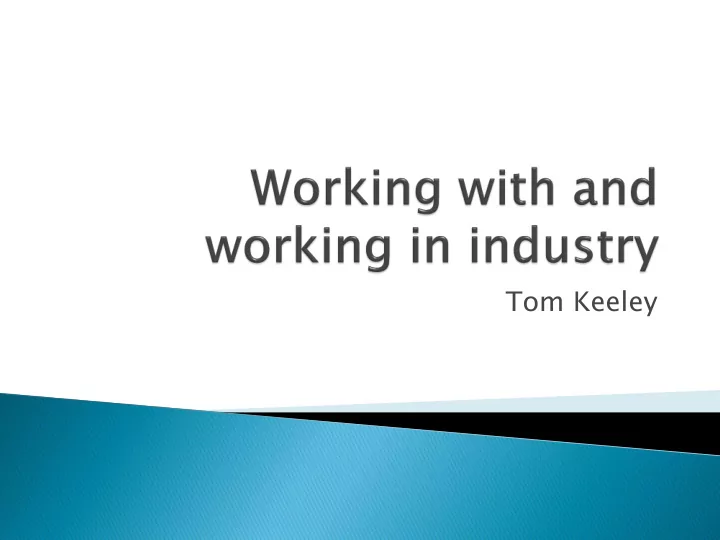

Tom Keeley
WORKING WITH INDUSTRY Industry structure Industry and academia WORKING IN INDUSTRY Should you make the move Making the move Questions.
Undergraduate, post-graduate, PhD student and Research Fellow at UoB. Health economics and Patient Reported Outcomes Moved to industry in 2016 Why I left academia: ◦ Looking for a different perspective ◦ Looking for a different metric of success ◦ Looking to be closer to patient benefit ◦ Looking for more money(!)
Consultant at PAREXEL ◦ Plan and produce research for pharmaceutical companies ◦ Main responsibilities include bringing in new business, project management and delivery of research. Scientific Director at GSK ◦ Based in the GSK Patient Centered Outcomes team ◦ Main responsibilities include strategic considerations across product development.
Legal Market CROs access Pharma Specialist Language scientific translations Technology solutions
Academi mia Industr try Greater equity between ensuring Deadlines and key time points are scientific standards and meeting the key driver deadlines/key time points Smaller team dynamic Larger team dynamic Informal/relationship based Clear lines of accountability structures Profit motive Profit motive Limited time and resources Limited time and resources
Research with scientific rigour. ◦ Need to involve key opinion leaders and experts in field to produce scientific research of high quality Supplementing a knowledge gap ◦ Industry partners will often look to fill “in house” knowledge gaps through collaborations with industry Adding credibility to research ◦ Partnering with world class academics will normally add credibility Issue raising ◦ Also, known as “issue seeding”.
Outcomes are aligned and similar Timelines are aligned and similar Expectations and responsibilities are understood by both sides Key investigators are unchanged throughout the project
Academi mia Industr try Greater equity between scientific Deadlines and key time points are standards and deadlines and key the key driver time points Smaller team dynamic Larger team dynamic Informal/relationship based Clear lines of accountability structures Responsibility sits largely with a Real responsibility in early career smaller number of key players Opportunity for ownership of Opportunity for management of direction of work projects Acronyms Lingo Local, National and Regional International Jack of all trades Master of one
English lish Langua guage ge Industr try Langu guage ge Contact, email, speak to “Reach out” Talk about “Speak to” Just about any report that is seen “Deliverable” by the client Power point presentation “Slide deck” This is crap and we need to start “This is sub-optimal, we need to again re-imagine, re-package and re- present this”
Professional Working independence dynamic Work-life Culture balance
Clearly demonstrable achievements ◦ Objective – action - result Proven ability to complete projects ◦ PhD, post-doctoral fellow study Any experience of working with industry ◦ However limited the experience, it is a positive Publications ◦ The impact factor of the journal is less important than being first author.
Use a recruiter where possible Establish information about the team you are moving to, as well as the company Do your research about key members of the team Understand the role you are applying for and how it differs from other opportunities Salaries come in bands and are not fixed, there will be a wage offer and negotiation If you don’t ask you don’t get
Masters qualification • Associate level – 25 to 40 K Masters qualification + 2 years • Senior associate level – 30-45K PhD qualification • Senior associate or consultant – 30-50k PhD qualification + 2 years • Consultant – 40-55K
Entry role Technical/ Managerial Consultancy Scientific
Questi stions ons and comment ments? s? 07779587641
Recommend
More recommend